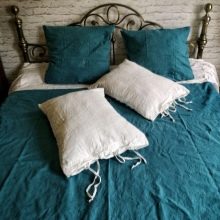All about linen bedding
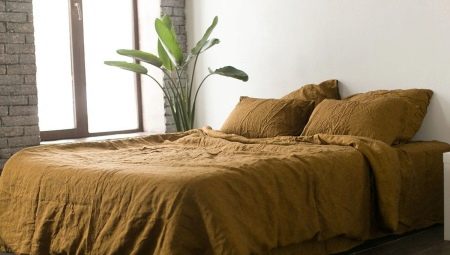
Linen is a material that is now experiencing a new wave of demand. For a while, it was undeservedly pushed into the background, giving way to brighter, and often just synthetic and semi-synthetic materials for bedding. But any expert will tell you how important it is to sleep under a natural fabric. And linen has become complementary to eco-style, Scandinavian style and many other stylistic trends.


Advantages and disadvantages
Due to its density, flax may seem rough to some. But the fabric works well, and linen made of linen has a number of valuable properties.
Pros of linen linen:
- natural composition with eco-friendly fiber;
- hygroscopicity and fast drying;
- high thermal conductivity - the material keeps the temperature in heat and cold;
- excellent air permeability - linen is 100% breathable;
- strength and durability;
- lack of electrification;
- no pellets;
- flax will not grow moldy during storage, even if used for a very long time;
- does not cause allergies;
- the possibility of a light massage effect due to the relief structure.

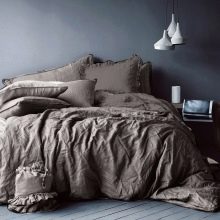

Cons of linen bedding:
- easily wrinkled;
- difficult to iron;
- can crumble significantly on cuts;
- if washed in hot water, the fabric will "shrink".
Obviously, the material has more advantages. And the fact that he hesitates, today few people upset - there is even a kind of charm of the material in this.


Types of linen for linen
In order for the fabric to turn into a successful material that contributes to falling asleep and comfortable sleep in general, they work with it.
By processing method
Linen can be printed - the finished fabric is specially dyed, it can be melange - the material is an interweaving of threads of different shades, multi-colored - fibers of different colors are used. If flax is called plain dyed, then it is easy to dye. Bleached linen means a material from which colored impurities are removed by alkaline solutions. And sour flax implies the use of sulfuric acid, which provides the material with softness and a delicate, cozy gray color.
Often they say about linen "linen" or "sheet". This is the name of a type of fabric that is made specifically for bedding or underwear. It can be 100% linen or a blended variation with a little cotton or synthetics.
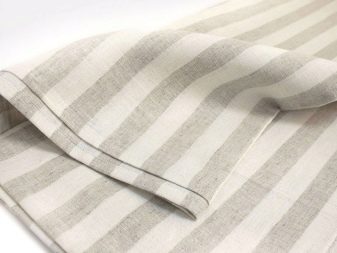
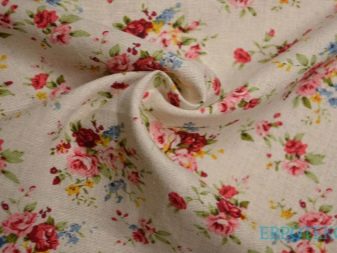
By weave type
Here everything is even simpler: the weave can be simple plain, small-patterned, translucent combined, openwork leno (the most decorative type) and jacquard large-patterned. It's hard to say which is better, everyone chooses to their taste. Someone wants maximum simplicity and naturalness, someone prefers bedding with an expressive print or pattern.


Manufacturers
When choosing a particular bed product, a person evaluates it according to a number of simple criteria: appearance, composition, design, price, recognition or reputation of the manufacturer. There are those who buy flax only made in the Russian Federation, assuming that linen is not widespread abroad, and the product is unlikely to be of high quality. This is stereotypical reasoning. For example, a linen sleeping set made in Belarus is a brand without a doubt.
It is worth highlighting a number of interesting brands.
- Jamido (Belarus). In addition to the quality selection of raw materials, the brand is engaged in the study of authentic prints, which eventually become part of the design of bedding products. These are very cozy, cute, delicate prints with floral motifs that will look perfect in a warm home interior.
They are especially good for eco-style.
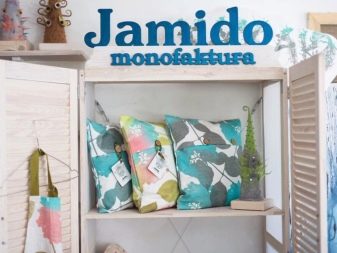

- Lenok (Belarus). Natural composition 100%, technological control and the use of all the qualities of flax in adaptation to the bedroom product. Competitive prices.

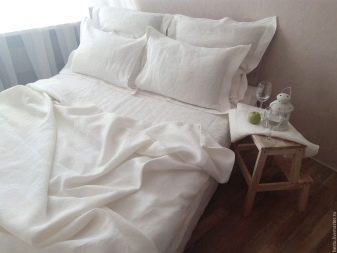
- Manufaktura Flaxeco (Belarus). Another very cute Belarusian brand offering linen bedding for children and adults. In some products, cotton is added to a minimum amount. The uniqueness of the product is also in the fact that all the work is done manually. Lingerie design impresses with Scandinavian style, kinfolk and other popular trends today.
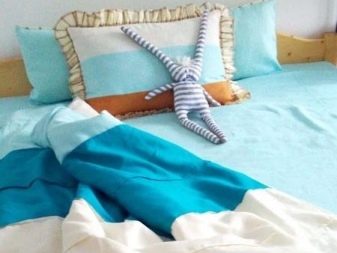

- Casual Avenue (Turkey). The manufacturer mixes linen, cotton and tencel. The latter material is the brainchild of eucalyptus cellulose, a breathable and natural fiber. The colors are calm, peaceful, cozy. The design is laconic.


- Luxberry Linen (Portugal). Bed linen is half linen, half cotton. This solution allows the materials to compensate for each other's shortcomings and multiply their advantages. Impeccable style, design that matches the most democratic interior styles.



- Blanc des Vosges (France). The manufacturer also offers mixed products (linen + cotton) that do not wrinkle so much and keep their shape well. Very nice color schemes, advanced design, but high price.

- "People's Flax" (Russia). Offers a variety of designs for bed linen. Checkered, floral motif, small and large patterns, whitened tones - here, indeed, you can pick up a set for every taste. Affordable prices.

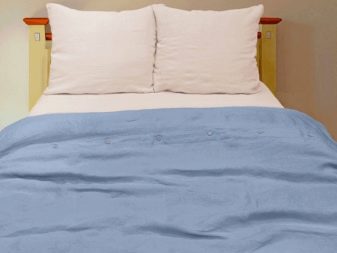
Softened bed linen is a material that will last not a couple of years, but much longer. It is pleasant to sleep under it in winter and summer; it is, indeed, a comfortable purchase.


How to choose?
First of all, you need to familiarize yourself with the composition. If the flax is not one hundred percent, and the material involves impurities, this is not bad. But you need to understand how the fabric will behave in operation, during washing, drying, ironing.And, finally, if there is only 30% linen in the composition, and there is a set at the price of 100% linen, it’s a shame to miscalculate.
Consider what else to evaluate when buying.
- Color, size. At the first wash, shrinkage is inevitable, but small, only 5%. True, not every manufacturer takes this into account and sews underwear with a margin, therefore it is imperative to pay attention to the size. Bed linens with the addition of cotton are especially susceptible to shrinkage. The color may also change during washing.
- Brand. An unknown manufacturer is always a risk. It is better to read reviews, familiarize yourself with the brand's reputation in advance, with how it positions itself in the market. So there are fewer disappointments.
In any case, the product must be certified.


If the material is blended, cotton, viscose and polyester are most often added to linen. Cotton is breathable and softens fabric. Viscose is a synthetic material that increases the elasticity of fabrics. Polyester reduces the cost of the kit by adding durability to the fabric, but also making it electrifying.
Examples of sets in the interior
These examples show how a linen set looks in the bedroom.
- Gorgeous green set. Suitable for a loft, and a Scandinavian style, and, of course, eco-style.

- A mixture of peach and pink against the background of a brick wall is very conducive to rest and relaxation.


- Restrained and laconic shades suitable for such calm, balanced interiors.


- Mustard color not cocky or particularly flamboyant, but it grabs all the attention. And also appropriate in eco-style.


- Classic stripes and discreet shades. The perfect combination for a wide variety of interior styles.

- Gray and white, check and graphics - a good addition for the snow-white Nordic style.

- The sheet with embroidery in ethnic style looks great. You can find a similar set with oriental motives.

How to wash?
Linen can be washed by hand or in a washing machine. They are washed as soon as the bed is removed from the bed. If the stains are old, they may not be washed off.
There are other features of washing flax.
- Before washing, the buttons on the duvet cover and pillowcase are fastened.
- The material should not come into direct contact with the powder. It is diluted in water in advance.
- The drum in the machine is only half-filled with laundry to ensure the wash cycle is good.
- Colored laundry needs to be washed using a special powder that will help the color last longer. Washing temperature - 40 degrees.
- If the linen is white, it may be acceptable to wash it at 60 degrees. The water may be slightly salted.
- Chlorine-containing substances are unacceptable in linen washing, as well as enzymatic bleaches. Such products will destroy the structure of linen without the possibility of recovery.
- The spinning of the material is admissible at 600 rpm, if more - you cannot get rid of folds and creases on the linen.



Over time, linen softens, so initially you can take a rough version, not be afraid that it will remain so.
How to dry and iron?
Drying flax with your hands is not worth it. It must be straightened, hung, allowing the water to drain itself. After spinning in the machine, it is necessary, without delay, to straighten the folds with your hands. If you send the material to the dryer, it is likely to shrink significantly. Flax dries quickly, if you can do it on the balcony or on the street, the material brought into the apartment will give off freshness and pleasant coolness (in the cold season).

But if it is decided to iron flax, which not everyone does, this will only work with a damp cloth. The temperature on the iron should be set to no more than 150 degrees. If the laundry has stopped shining, the outer fibers may be fuzzy. If you iron it from the front, most likely the shine will return. Then the linen is hung up again until dry: you cannot iron it until it is completely dry.
Linen is rightly considered a therapeutic substance that helps you fall asleep calmly and get enough sleep. Its texture is pleasant to the skin, and the aroma of freshness after drying relaxes and soothes.
